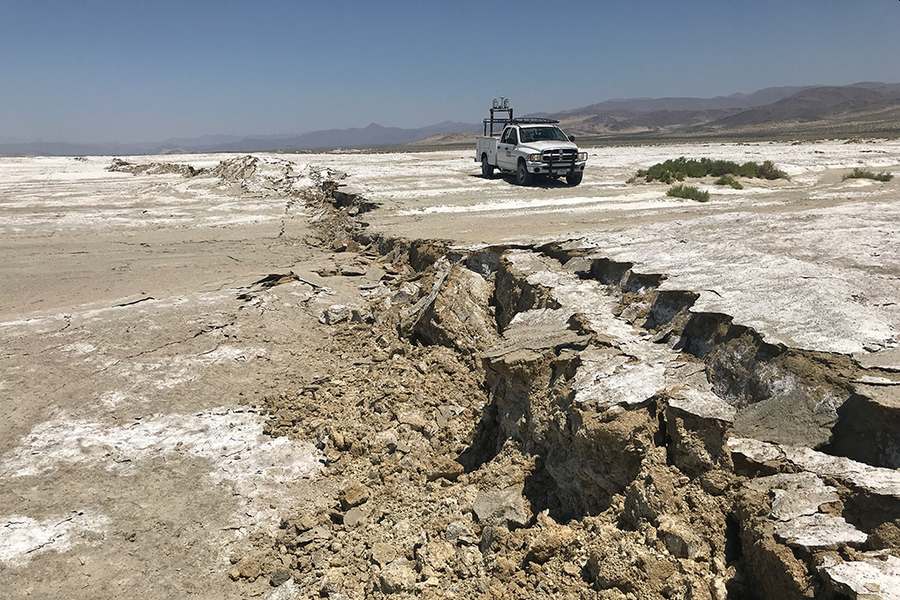Damage in the Earth’s deeper depths emerges gradually, long after the main earthquake event

When people think of earthquakes, they often picture scenes of devastation — the ground splitting apart and landscapes being reshaped. Yet, once the shaking ends, the surrounding area enters a stage known as post-seismic deformation. During this time, even regions that didn’t crack open experience new stress as the Earth’s crust adjusts to the sudden shifts. Eventually, these areas settle into a new state of balance and recovery.
For a long time, geologists believed that this recovery process occurred gradually and continuously. However, new research from MIT, published in Science, reveals a more complex story. The study found that healing happens quickly in the shallow layers of the Earth — roughly within the top 10km — but takes much longer, or may not occur at all, in deeper layers. “If you compared the shallow crust before and after an earthquake, you’d hardly notice any lasting change. But the mid-crust tells a different story — it holds on to permanent changes,” explains Jared Bryan, an MIT graduate student in the Department of Earth, Atmospheric and Planetary Sciences (EAPS) and the paper’s lead author. The study also involved Professor William Frank of EAPS and Pascal Audet from the University of Ottawa.
To explore how the crust behaves before, during, and after an earthquake, the researchers analyzed seismic data from the 2019 Ridgecrest earthquakes in California — the largest in the state in two decades. This young fault zone generated tens of thousands of aftershocks in the following year. The team filtered out seismic signals from the Ridgecrest events themselves and instead examined waves from other earthquakes around the world to see how their travel paths changed. They also used background vibrations, such as those from ocean waves and human activity, as additional data. By applying a method called a receiver function, they could measure how seismic waves moved through the crust, revealing shifts in rock properties like density and porosity — much like sonar helps map underwater features.
The findings showed that the shallow crust, extending about 10 kilometers deep, recovered within a few months after the earthquake. In contrast, the mid-crust exhibited slower, delayed changes that continued as the upper layers stabilized. “What surprised us was how quickly the shallow crust healed, while deeper regions evolved over the same timescale — not during the quake, but afterward,” Bryan notes. This suggests that the crust’s response to seismic activity is far more dynamic and layered than previously thought.
Understanding how the Earth’s crust recovers at different depths is vital for assessing the planet’s energy budget — the balance of energy released as seismic waves, stored as elastic strain, or used to create fractures. Yet, scientists still don’t know how long it takes for deeper layers to recover, if they ever do. The study proposes two possibilities: either the deep crust heals over much longer periods, or it never fully returns to its original state. “Both outcomes challenge our expectations — and both are fascinating,” says Frank. Future research aims to gather more observations to pinpoint where these changes become most pronounced and to compare results from older, more active fault zones. As Bryan humorously adds, “We’ll let you know in a thousand years whether it’s recovered.”
Sources: news.mit.edu, ebs.publicnow.com
Want to read more like this story?

University of Alaska Fairbanks: They developed an algorithm that can predict earthquakes
Sep, 02, 2024 | NewsThe University of Alaska Fairbanks (UAF) published revolutionary research in Nature Communications...
Earthquake Engineering
Jan, 01, 2019 | EducationEarthquake engineering is a critical field of civil engineering that focuses on the analysis, desi...

5.8-magnitude earthquake strikes Ecuador coast: damaged buildings, huge loss of property, no tsunami
Mar, 28, 2022 | NewsA huge loss of property was suffered when an earthquake of magnitude 5.8 struck Ecuador coast on Sa...

Can scientists predict a strong earthquake months before the event?
Nov, 29, 2023 | NewsSeismologists have revealed a study proposing the prediction of strong earthquakes by identifying e...

Earthquakes: five deadliest earthquakes ever recorded around the world
Feb, 24, 2022 | NewsEarthquakes are one of the most dangerous natural disasters. More than 100 earthquakes of the magni...

Earthquake prediction in the lab using deep learning
Nov, 09, 2021 | NewsLives and billions of dollars in infrastructure damage every year is the cost of earthquakes in the...

Messina earthquake (1908): a civil engineering landmark
May, 26, 2023 | EducationThe 1908 Messina earthquake, also known as the Great Reggio earthquake, is considered as one of t...

Innovative strategies in earthquake-resistant building design: ensuring safety and structural integrity
Jul, 16, 2024 | NewsThe major concern that engineers and architects have when they design a new building is to ensure t...

New study claims that surface hazards, e.g. landslides, can cause earthquakes
Jun, 20, 2024 | NewsA new study conducted by the Swiss Federal Institute for Forest, Snow and Landscape Research (WSL)...
Trending

Spectacular interchanges around the world

New Release - STAAD.Pro 2024 - 2

ADINA 2025 for Structural WorkSuite

ADINA 2025 New Release!

Concrete Buildings as Rechargeable Batteries

Powerful earthquake shakes central Philippines, dozens killed

Indonesia school collapse: three fatalities and dozens injured

